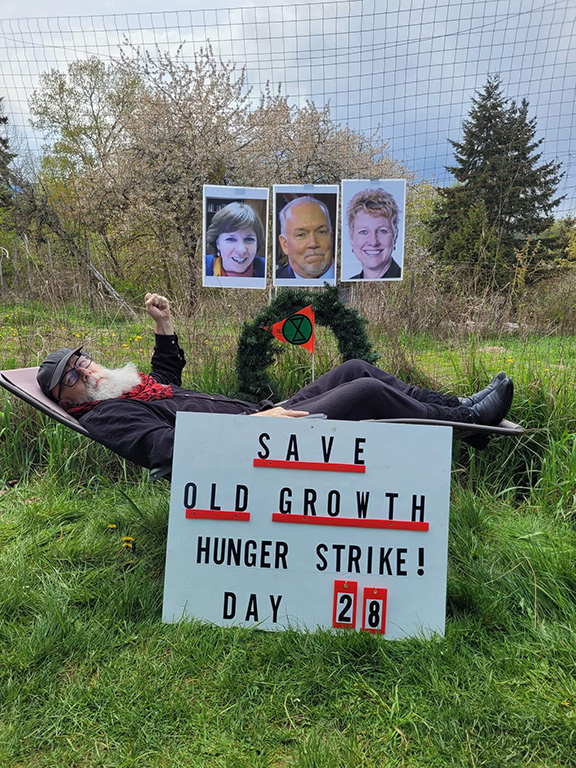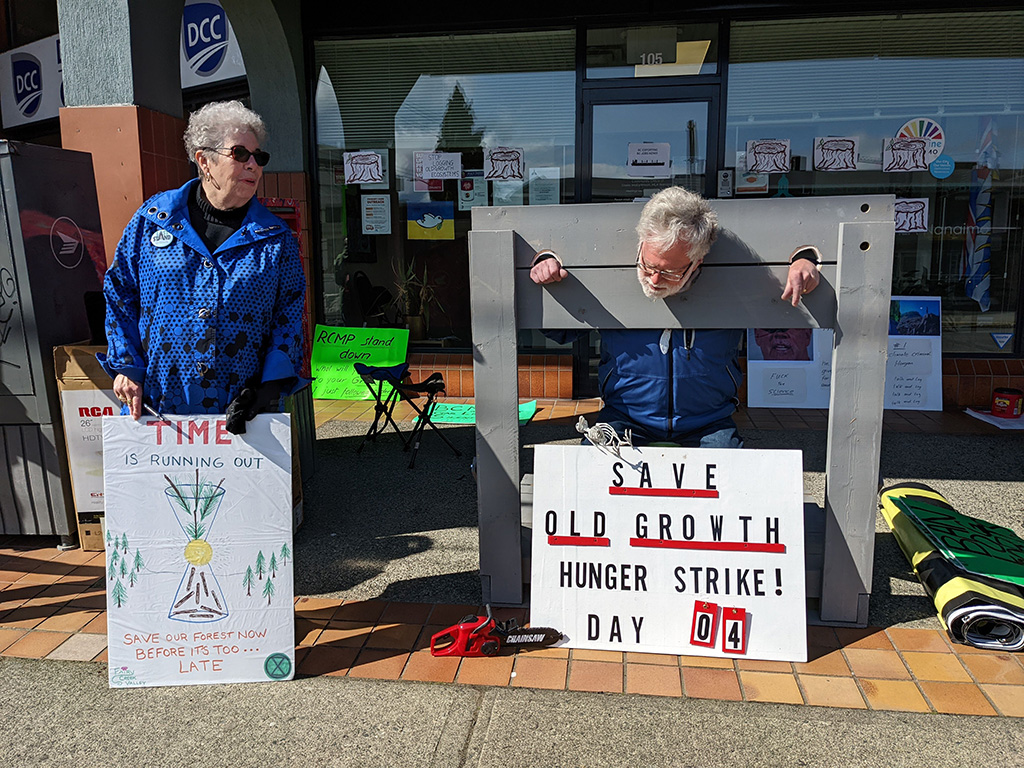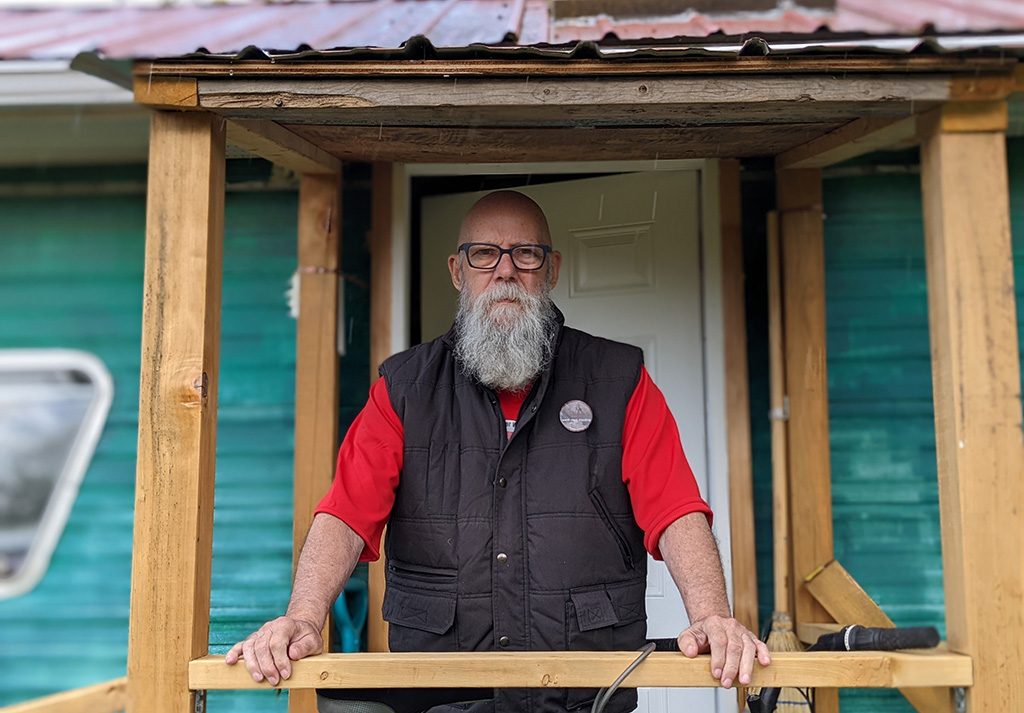Howard Breen was on day 27 of his hunger strike when I spent some hours with him last Wednesday at his back-lot south Nanaimo cabin. Three days before he had been in hospital with memory loss, dangerously low blood pressure and impending kidney damage — brought on when he also refused water for 51 hours. But on this unseasonably frigid April day, in the warmth of his cabin, Breen seemed to have recovered his strength as he compared the importance of his cause to the life and death struggle of the Second World War.
“I’m not prepared to abandon my children,” he said. “But I just see this: My relations didn’t take a pause from fighting fascism.”
Breen, who has three children and six grandkids, had stopped eating on April 1 to raise awareness of the global climate chaos that is manifesting in British Columbia as destructive and deadly heat waves, floods and fires. Six days later he found himself in solitary confinement in the regional prison in Victoria, held without bail for eight days for obstructing a Royal Bank branch in Nanaimo to protest its heavy financing of fossil fuel projects. Now he is under house arrest.
“I don’t fear prison,” Breen said. “I don’t fear what will ultimately happen with this hunger strike. What I fear is that I’m not doing enough, for my children and their children.”
Pinching his sides to show that he still had fat to burn nearly a month after his last meal — a vegan casserole — Breen vowed to forego sustenance well into May. He also said he was considering a second water fast: “I haven’t ruled that out myself to end that way — to take it to the limit again.”
He said this, however, before he started slurring his speech, spouting gibberish and having dizzy spells Saturday evening. That was it for his medical team — Breen’s daughter Sky, a cardiac nurse, and Vancouver-based family doctor Linda Thyer, a founding member of the activist group Doctors for Planetary Health.
He’d gone 31 days.
“With there [sic] clear perspective observing my decline, there is absolutely no point whatsoever in pressing further,” Breen wrote me that night. “31 days without food, I now have to closely follow re-feeding startup instructions.”
Breen said he was convinced that he’d proven already that the B.C. government wasn’t going to meet the strike’s specific demand, which is for Premier John Horgan and B.C. Forests Minister Katrine Conroy to join a public meeting and explain how the province’s continued logging of old-growth forests can be justified given their potent capacity to strip climate-warping carbon dioxide out of Earth’s atmosphere.
“Conroy and the cabinet are prepared to let me die… to protect their own political agenda,” said Breen.
But the battle rages on. Retired Nanaimo pharmacist Vic Brice, who was arrested with Breen at the Royal Bank last month, launched his own hunger strike in solidarity nine days ago and is pressing on.
A ‘continual upping of the ante’ by activists
Climate activism via self-sacrifice such as Breen and Brice’s is on the rise globally, as campaigners seek to arouse public attention and force government action.
A swarm of “direct action” activists in B.C. have ensnarled bridges and highways — acts that earned a fine in years past and are now yielding prison sentences. A growing number of activists in the U.K. are deliberating seeking imprisonment. And climate-focused hunger strikes are suddenly everywhere. Breen’s strike was inspired by Vancouver-based labour organizer and activist Brent Eichler, who went 33 days on water, lemon juice, salt and vitamins before passing the baton to Breen last month.
Colorado activist Wynn Bruce made the ultimate sacrifice last month in a harrowing Earth Day self-immolation at the U.S. Supreme Court. Video shared online captured him engulfed in flames and burning in silence for 60 seconds, then screaming when police douse him with water. He was 50-years-old.
“We have been seeing over the last few years this continual upping of the ante because things lose their novelty value, and that’s critical for getting media attention,” said Colin Davis, chair in cognitive psychology at the University of Bristol. Davis studies how people interpret protest messaging and is a climate activist himself through the U.K.-born direct action movement Extinction Rebellion.
Practitioners of non-violent sacrificial protest include universal moral icons like Nelson Mandela, Russian opposition leader Alexei Navalny and Attawapiskat Chief Theresa Spence. Still, the practice remains controversial because the acts are inherently coercive, emotionally entrapping anyone with at least a sliver of empathy.
Davis says there is also a risk that they could prove counter-productive to climate protection.
“Sacrificial protest tends to be highly polarizing,” said Davis. “People who are not concerned about climate change may say, ‘Well, I always knew that these people were crazy and this just confirms it for me.'”

Breen’s hunger strike was the culmination of a lifetime of overcoming adversity, and a long career of non-violent protest.
When we met last week he talked about spending his first two years in an orphanage, being drugged and assaulted by his elementary school religion teacher when he was 15, seeking his birth parents and overcoming alcoholism — topics he’s never before shared publicly. He explained that the outpouring of support he’s experienced during the hunger strike has been both loving and taxing. “It’s not my way to be that exposed,” he said.
Breen also recounted his early years of activism that cemented his belief and honed his skills in non-violent and direct-action protest. Originally based in Ontario but acting internationally, he garnered 14 convictions stemming from environmental, human rights and peace protests.
He established a peace camp on the Iraqi-Saudi border during the Gulf War, was deported from Israel for co-organizing a peace walk in the occupied Palestinian Territories, shut down Canada’s National Department of Defense to protest NATO flights disrupting Inuit hunters, and more.
Breen put all that on ice when he came to B.C. in 1991 and settled down to raise a family, working on staff at several environmental non-profits. But in the past five years he’s returned to non-violent protest.
In 2018 he co-founded the Vancouver Island extension of Extinction Rebellion after being arrested for shutting down Victoria's Johnson Street Bridge. Breen’s arrest while literally glued to the door of the Nanaimo RBC Branch landed on April 7 — his birthday — and was the third such annual present to himself in a row.
That extensive record explains how Crown prosecutors managed to place him at Victoria’s Wilkinson Road prison, and since then under house arrest.
Whatever one might think about Breen’s life choices, it’s hard to impugn his concern for his childrens’ futures. Climate change has begun and science shows it will get worse without rapid and decisive action, yet British Columbia has a (tragically) perfect record of missing its targets for cutting the carbon emissions driving the problem.
Analysis of government data for the yearlong Decarbonizing Cascadia regional reporting project showed how B.C. greenhouse gas emissions have been rising for a decade. The government’s own data also documents how clear cutting, infestations and fires have shifted B.C.'s forests from absorbers to net producers of carbon — close to or larger than emissions from all of the province’s industries, vehicles and buildings combined, depending on the year.
The latest round of reports from United Nations scientists, meanwhile, say dramatic action is required by 2030 to head off the worst effects of climate change. UN Secretary-General António Guterres called it "a code red for humanity. The alarm bells are deafening, and the evidence is irrefutable.”
Eichler, Breen and now Brice are demanding a public meeting with Horgan and Conroy to help B.C. citizens connect the dots, grasp the stakes and demand accelerated action to, as Breen put it, “protect the most critical forests that are saving our lives.”
Horgan and his government have rejected the B.C. hunger strikers’ call for a public meeting while talking up the steps they have already taken to preserve more of B.C.’s old growth. And last week they went on the offensive against direct action protesters — a move that Conroy extended to the hunger strikers in a statement to The Tyee last week. The minister accused the hunger strikers of being part of a “small group” whose tactics are “crossing the line” and “raising anger rather than awareness.”
At the same time, the government carefully avoids connecting the climate and forest dots. Minister Conroy’s statement was provided in response to climate-related questions sent to Minister for Environment and Climate Change George Heyman, which his office said he wanted to answer. But Conroy’s statement did not mention climate change.
The government’s perceived indifference to his fate stung Breen, a lifelong NDP member-activist, as a deep and personal betrayal. He pointed to his long association with Sheila Malcolmson, Nanaimo’s MLA and B.C.’s minister of mental health and addictions, who has refused to meet him for a year and didn’t reach out during his hunger strike. “Not even a ‘How you doing Howard?’” said Breen, recounting his long association with Malcolmson during her career with the Islands Trust, which overlapped with Breen’s time on Gabriola Island, and how he backed her “underdog” run for the riding nomination.
He said he’s done with the BC NDP, and has been asking friends in the party: “What makes you think they wouldn’t do the same to you?”
Malcolmson’s constituency office told The Tyee last week she was unavailable.
How people perceive hunger strikers
The hunger strike tactic employed by Eichler, Breen and Brice pose risks for both the actor and the government.
It clearly creates a dilemma for authorities. As Davis put it: “On the one hand, they don’t want to be bossed around. On the other hand, it can reflect very badly on the government and policy-makers if someone were to die.”
Death is the obvious and ultimate risk for the hunger striker. And even the majority who survive can be seriously harmed. Prolonged lack of nourishment also increases vulnerability to infection — a particular concern amidst COVID-19 — and can lead to organ failure.
Margaret Thatcher never did bend to the will of Bobby Sands and other IRA militants during their 1981 hunger strike for better prison conditions, even after Sands won a seat in the U.K. parliament in a snap byelection. Ten prisoners, including Sands, starved themselves to death.
Davis is convinced that if hunger strikes for climate continue to multiply, someone will inevitably die.
What he can’t begin to predict, even in 2022, is how society will respond. Will the dead become martyrs, as did the IRA strikers? Their deaths paved the way to Sinn Fein’s ascension to political power in Ireland and, ultimately, the withdrawal of British troops.
Or, asked Davis, “Will the people controlling the narrative say, ‘Well this is just another unfortunate manifestation of mental illness and let’s all just try and look the other way’?”
Only a handful of news outlets reported Wynn Bruce’s act of self-sacrifice last month, and Davis bets this is because many viewed his immolation as a suicide.
Davis views that dismissal as unfair, because research on survivors of self-immolation has shown that it’s not a manifestation of mental illness. “This is a public form of protest done to try to generate attention,” he said. Silencing activists who use extreme measures, he said, merely serves to insulate the authorities who are being protested.
His own research casts doubt on another dismissal of protesting through self-sacrifice: the argument that onlookers will perceive the activist as immoral and actually reduce support for their cause.
Davis says he has done online survey experiments, as yet unpublished, that suggest that people who say they disapprove of a protest’s methods can nevertheless end up being swayed in favour of the cause. “They might shoot the messenger, but they’re still somewhat swayed towards the message,” said Davis.

For Breen, the takeaway lesson from Bobby Sands and the Irish Republicans’ hunger strike is that, “in order to succeed the world must hear about it. Otherwise, you will only die behind bars as a criminal not a political prisoner.”
His own brush with death apparently averted, Breen can begin imagining, again, his own future on the planet. His youngest has a shot at representing Canada on the rugby pitch next year at the Olympics. As Breen said the day we met, he’d “really like to be around to encourage him.”
Vic Brice shared some views last week about the risks facing the hunger strikers and their cause when I found him locked into mock stocks in front of Minister Malcolmson’s downtown Nanaimo constituency office.
Did Brice feel prepared to put his health or even life at risk? “Our lives are all in danger,” he replied.
Was Brice concerned that more numerous and extreme climate protests might numb the public?
“The public is numb already. I mean the public was pissed off at us for blocking the road because that inconvenienced them for a few minutes. Okay. I'm not inconveniencing them here. Maybe they could give us a bit of support. Call their MLA, call the premier, send an email to the prime minister. Tell them to do their job.” ![]()
Read more: Rights + Justice, BC Politics, Environment
















Tyee Commenting Guidelines
Comments that violate guidelines risk being deleted, and violations may result in a temporary or permanent user ban. Maintain the spirit of good conversation to stay in the discussion.
*Please note The Tyee is not a forum for spreading misinformation about COVID-19, denying its existence or minimizing its risk to public health.
Do:
Do not: